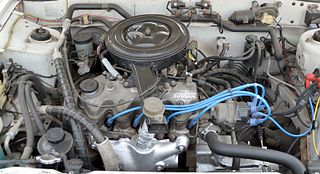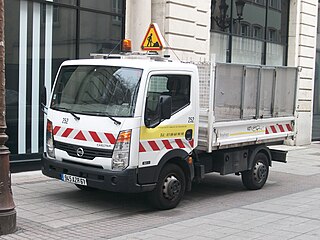After an early flirtation with V-twin engines, Mazda's small cars of the 1960s were powered by OHV straight-2 and straight-4 engines. This family lasted from 1961 until the mid-1970s. Today, Mazda's keicars use Suzuki engines. It was produced at the Hiroshima Plant in Hiroshima, Japan.

The VG engine is a family of V6 engines designed and produced by Nissan between 1983 and 2004.

The Ferrari Lampredi engine was a naturally aspirated all aluminum 60° V12 engine produced between 1950 and 1959. Inline-4 and Inline-6 variants for racing were derived from it.

The Nissan E series name was used on two types of automobile engines. The first was an OHV line used in the late 1950s and throughout the 1960s. The second was an OHC version ranging from 1.0 to 1.6 litres and was produced from 1981 till 1988. It was replaced by the GA engine series.
The Nissan H series of automobile engines is an evolution of the Nissan "R" engine which was based on the 1.5-liter, three-main bearing "G" engine used in the 1960s. Both inline-four and inline-six versions were produced. It is a pushrod OHV design with iron block, early models with an iron head, later models with aluminum head. Versions of this motor have been used in many Nissan autos and forklifts, well into the eighties and a version called H20II was in production until 2003. The SD diesels are based on this series of motors

The Nissan L series of automobile engines was produced from 1966 through 1986 in both inline-four and inline-six configurations ranging from 1.3 L to 2.8 L. It is a two-valves per cylinder SOHC non-crossflow engine, with an iron block and an aluminium head. It was the engine of the Datsun 510, Datsun 240Z sports car, and the Nissan Maxima. These engines are known for their reliability, durability, and parts interchangeability.

The Nissan Z engine is a series of automobile and light truck four-cylinder engines that was engineered by Nissan Machinery, manufactured by the Nissan Motor Company from 1979 through August 1989. All Z engines had 4 cylinders, a total of 8 valves and a single overhead camshaft (SOHC). Displacements ranged from 1.6 L to 2.4 L.The Z series' engine blocks were nearly identical to those of the earlier L Series with the exception of the Z24. While the Z16 and Z18 engines had a deck height similar to the earlier L13/L14/L16/L18 variants, the Z24 had a taller deck height to accommodate a longer stroke. The most notable difference between the Z-series engine and its predecessor was the introduction of a new crossflow cylinder head which reduced emissions by moving the intake ports to the right side of the engine opposite the exhaust ports. This change allows the exhaust port velocity to more effectively scavenge the cylinder and reduce reversion pulses to enhance induction. This change also limits maximum valve lift/lobe lift profiles rendering the cylinder head and valve train configuration undesirable for high-performance uses. The Z series evolved into the NA and KA engines which, along with the smaller CA series, replaced the Z series.
The Nissan D-series is an overhead valve series of engines which first appeared in 1964, with the 1.05-liter D engine. Similar to a number of British and other Datsun engines, it may have been derived from an Ohta design which also found its way into some Kurogane vehicles - both of these companies were swallowed up by Nissan in the early 1960s.

The Prince G-series engine was the company's only straight-four and straight-six engines which began production in 1955. A number of variations were made, with both OHV and OHC heads. A diesel four-cylinder with 1.9 L (1,862 cc) was also built, called the D-6. The G series was used in the Skyline, the Laurel, and the Gloria from the 1950s to the early 1970s.

The Nissan J series are straight-4 and straight-6 gasoline internal combustion engines produced by Nissan from the 1960s through the 1980s. It is similar to the BMC B-Series engine that was built in Japan under licence as the Nissan 1H before being de-stroked to become the 1.0 L Nissan C and 1.2 L Nissan E engines, but wasn't a direct copy.
The SD engine was replaced by the Nissan TD engine. It was manufactured by Minsei Diesel Industries, Ltd., which was renamed Nissan Diesel Motor Co., Ltd in 1960.

Nissan Cabstar is the name used in Japan for two lines of pickup trucks and light commercial vehicles sold by Nissan and built by UD Nissan Diesel, a Volvo AB company and by Renault-Nissan Alliance for the European market. The name originated with the 1968 Datsun Cabstar, but this was gradually changed over to "Nissan" badging in the early 1980s. The lighter range replaced the earlier Cabstar and Homer, while the heavier Caball and Clipper were replaced by the 2-4 ton range Atlas (kana:日産・アトラス). The nameplate was first introduced in December 1981.The Cabstar is known also as the Nissan Cabstar, Renault Maxity and Samsung SV110 depending on the location. The range has been sold around the world. It shares its platform with the Nissan Caravan. In spring 2014, Cabstar is now known as NT400.
The Prince Miler is a medium-sized pickup truck built by the Prince Motor Company. It remained on the market for four years after the 1966 merger, when Prince dealerships became integrated within Nissan's organization as Nissan Prince Store. By 1970, however, it was integrated with Nissan's newest generation of their offering in this class, the Junior.

The Nissan QD engine, successor to the Nissan TD engine, was an inline four-cylinder overhead valve diesel produced from the mid-1990s through 2000, with a turbocharger used on three variants, the QD32ETi(Elgrand and Terrano) QD32T and Qd32Ti(intercooled) in Chinese Markets. It was replaced by the Nissan ZD engine.
The BD is an automotive diesel engine produced by Nissan Diesel. BD is specified as a 4-cylinder, direct fuel injection, water-cooled naturally aspirated engine.

The Nissan Junior was a series of medium-sized pickup trucks built from 1956 until 1982. It was introduced to fill the gap between the smaller, Datsun Bluebird based Datsun Truck, and heavier load capacity Nissans under the Nissan Diesel brand, like the 80-series trucks. After the merger with Prince Motor Company, the Junior and the Prince Miler were combined, sharing most of the characteristics, with the Junior sold at Nissan Bluebird Store Japanese dealerships, and the Miler sold at Nissan Prince Store until 1970.

The Nissan Caball is a light commercial truck manufactured by Nissan Motors from December 1957 until December 1981. The Caball was mainly sold in Japan, Hong Kong, South East Asian countries, Australia, New Zealand, and few European countries and shared the Nissan Junior platform. While the Caball name came to an end in 1981 with the cancellation of the Junior, its larger replacement received the Nissan Atlas name in the domestic Japanese market. These are 2-4 ton trucks, the lighter versions in the Atlas truck range took over after the lesser Cabstar/Homer. In Japan, it was available at Nissan Store locations and replaced by the Nissan Atlas.

Nissan's sidevalve engines were based on the Austin 7 engine, with which they shared the 76 mm (2.99 in) stroke. The series began with a 495 cc iteration for the 1930 Datson Type 10 and ended with the 860 cc Type 10 engine which was built until 1964 for light commercial vehicles. Later versions were called the B-1, before being replaced in 1957 by the OHV Nissan C engine that was essentially a de-stroked version of another Austin design this time the BMC B-Series.












